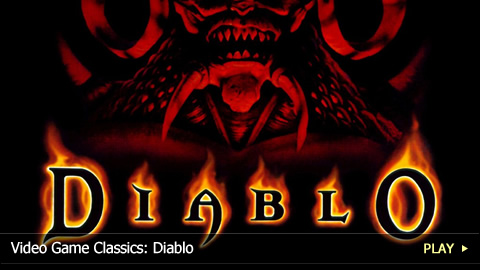Video Game Classics: Diablo

Death by mouse clicks. Some games will live forever as classics. Welcome to Watchmojo.com, and today we’ll be taking a look back at the legendary dungeon crawler: Diablo.
Developed by Blizzard Entertainment in 1996, Diablo is action RPG for PC and Mac that had players clicking their way through hordes of Skeletons, Goblins, Demons and eventually the Devil himself. Players had the option to tackle the minions of hell by themselves, or in party of up to 4 heroes.
Set in the world of Sanctuary, players begin the game as a hero that has newly arrived in the town of Tristram. Things in Tristram are apparently pretty grim. The townspeople are frequently terrorized in the night by unknown horrors and have thusly been reduced to just a handful of survivors.
The game’s back-story is a convoluted tale involving a civil war, a mad king, a mysterious archbishop and unknown evil sweeping the land. However, very little of all this is important to the new hero. What is important, is that the Cathedral on the edge of town is clearly full of monsters, and it just so happens that the townspeople want our hero to check it out.
As the game begins, players select their hero from one of three classes: the Warrior, the Rogue and the Wizard. The Wizard is a ranged magic user, the Rogue primarily uses a bow, and the Warrior uses a wide variety of blunt and pointy objects to dismember his foes from up close.
Despite having some rather complex RPG elements, game-play in Diablo couldn’t be simpler. Wanna go over there? Click the ground where you want to go. Want to pick up that item on the ground? Click it. Talk to that guy? Click. Bash that skeleton with your mace? Well, you get the picture…
Often labeled a “Dungeon Crawler”, Diablo has players progress through various dungeon-esq locations leaving a path of slain monsters in their wake. Each defeated enemy grants the player experience points, and collecting enough of these points grants the player a “Level Up”.
Leveling up awards the player with five points to distribute among four major attributes, namely strength, dexterity, magic and vitality. Strength is most important for Warriors as it governs the amount of physical damage they deal. Dexterity governs one’s chance to hit and is thus most important to the Rogue, and Magic, as you may have guessed, is most important to the Wizard class as it determines the effectiveness of spell casting. Vitality governs the amount of total health a player has and is thus an attribute that is generally used by every class.
In addition to leveling up, players need to make their heroes more powerful by equipping them with more powerful items. Slain enemies drop weapons and armor that can be equipped by the player. The farther one progresses, the better the dropped equipment becomes. This is turn becomes one of the game’s most insanely addictive qualities; the possibility that the next enemy might drop an even better sword than the one you have was enough to keep many players up into the wee hours of the night.
Coupled with Diablo’s addictive loot hunting mechanic was its devilish atmosphere. Gloomy environments, vicious enemies and an unforgettable soundtrack all made for an experience that was surprisingly frightening. Anyone who played the original will tell you that they positively wet themselves when they first encountered “The Butcher”.
Although the player is tasked with a number of quests throughout the course of the game, the main goal soon takes shape as the adventure draws towards its climax: you must slay the Diablo, The Lord of Terror. After working through the Cathedral, the Catacombs and the Caves, players enter Hell itself and are forced to go toe to toe with Big Red himself. Whether or not they are fully prepared for this fight another story…
A testament to how well Diablo’s game-play formula worked, recent games that mimic its game-play are often dubbed “Diablo clones”. While there have been two sequels in the series, many enthusiasts will argue that neither has come close to the terrifying and addictive click-fest that was the original.
